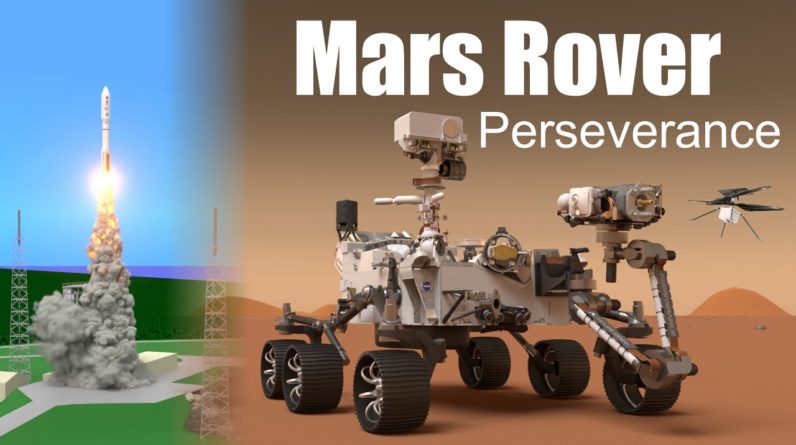
– [Jared] This is the
Mars Rover Perseverance, the most advanced robot
to land on another planet. In this video, we'll take
a look at how it was built, the Atlas V launch, the journey to Mars, and the scientific instruments that allow it to study the surface. (dissonant electronic music) This video is sponsored by Morning Brew. (dramatic ethereal music begins) On February 18, 2021, the Perseverance rover successfully touched down on Mars. It costs a total of 2.5
billion U.S. dollars. It has many scientific instruments to help study Mars
search for signs of life and prepare the way for
future human explorers. Perseverance is of course not
the first rover to visit Mars. Sojourner was in 1997, a very small rover, and here's a person for size comparison. Spirit and Opportunity, in 2004. These were identical rovers sent just a few weeks
apart from each other. Curiosity landed in 2012 and then Perseverance in 2021, same size as Curiosity, but
much more advanced technology.
This is not a complete list. This just shows the most recent rovers sent by NASA in the United States. For most of this video, I'll
be focusing on Perseverance. NASA designs and builds the
rovers in Pasadena, California, at the Jet Propulsion
Laboratory, or JPL for short. This took about eight years
of designing, building, and testing to get
Perseverance ready to go. It was built in a clean room that's free from dust
or other contaminants. It's designed to work on another planet, different atmosphere, different gravity, and most of all no repair station.
It has to be engineered so well that it can last for years on its own. On top of that, it has
to be light and compact so it can fit inside
of the launch vehicle. Once it was ready to go, the
rover was carefully packaged up and then flown across the United States to Kennedy Space Center in Florida. This is where the launch
happened, the same place that NASA has been launching
rockets since the 1960s. Perseverance was installed along with several other components that went along for the journey to Mars.
We'll talk about each one of these pieces later in the video. This was all put inside
of the Payload Fairing, then taken to the rocket and
then lifted up to the very top. This rocket is called an Atlas V. It's made by a company called
the United Launch Alliance, or ULA for short. Let me point out that the rover was actually upside down for the launch. The best time to launch to
Mars is about every 26 months. If we show this with the correct scale, you can barely even see the Sun. For this animation, I'm
gonna show this out of scale so we can see this a little better. For the Earth to get around the Sun, it takes exactly one year, right? No surprises there. Mars, on the other hand,
takes almost two years to get around the Sun. The best time to launch is right before Earth
and Mars are lined up.
This is called a Launch Window, and it happens about every 26 months. Perseverance was launched
on July 30, 2020. (dramatic ethereal music continues) The four solid rocket boosters
use up all their fuel first. At 1:49, they are jettisoned,
or separated, from the rocket. At 3:27, the payload
fairing is jettisoned, which exposes the spacecraft. Next up, the main
booster runs out of fuel. At 4:28, the main booster is separated, and it will fall back to the Earth.
This is called the Centaur Stage. Its main engine now fires up. This is what gets us into
orbit around the Earth. At 11:30, the engines shut off. This is called the Coast Phase. We'll stay here for about a half-hour. It's a good time to check
things out and make sure that everything is still
working as it should. And then, we relight the
engines for about eight minutes. This is called the Earth Escape Burn. This is what gets us
on a path towards Mars. Then the spacecraft separates. It's traveling at 41,000
kilometers per hour, and it will take about
seven months to reach Mars. Our spacecraft is made up of a few pieces. Here's the rover, all folded
up inside the Descent Stage.
This has eight rocket engines on it. The Heat Shield, which slows us down through the atmosphere
and protects the rover. The Backshell, which protects the rover as it descends to the surface of Mars. And this is the Cruise Stage,
provides power, fuel tanks and thrusters, and also keeps
in communication with Earth. This whole assembly stays together during the seven-month journey to Mars. We'll need to adjust
our path along the way. We do this with the thrusters on the side of the cruise stage. This is called a Trajectory
Correction Maneuver, or TCM, and there are several of
them on the way to Mars. (dramatic ethereal music continues) Landing on the surface of Mars
is nothing short of intense. They call this EDL, or
Entry, Descent, and Landing, often nicknamed the 7 Minutes of Terror. This is because, if anything goes wrong, it will likely fail to get the
rover safely to the surface. At the time of landing, it
will take about 11 minutes for any signals to reach Earth. This is, of course, traveling
at the speed of light, the fastest that we
know how to communicate.
It doesn't seem very fast, does it? 11 minutes is a long time. To put this in perspective,
from Earth to the Moon, light takes just over
one second to get there. When the Apollo astronauts
were landing on the Moon, NASA could communicate with
them almost in real time. It would take about 2 1/2
seconds to receive a reply. On Mars, this is completely different. If something goes wrong
during the landing, Mission Control won't hear
about it for 11 minutes, and any reply would
take another 11 minutes to get all the way back. By this point, it will already be over, either a safe landing or a crash. This means the computers,
electronics, and the software must be smart enough to do
everything on their own. EDL: Entry, Descent, and Landing. Let's follow this through step by step. About 10 minutes before
entering the atmosphere, the Cruise Stage is detached
because it's no longer needed. Small thrusters on the backshell will now be used to steer the spacecraft. Next comes atmospheric entry.
The heat shield will protect
the rover during this time. (dramatic ethereal music continues) Once we get about 11
kilometers above the ground, then the parachute can deploy. It uses a technology called Range Trigger which finds out how close
we are from the landing site and then deploys the parachute
at just the right moment. Next step is Heat Shield Separation. For the first time, the Perseverance rover can now see the Martian
surface down below. Now we use Terrain Relative Navigation. The rover will be taking
pictures of the ground beneath it and comparing these to maps of Mars.
This will be used to
safely steer the rover towards the intended landing site. Next comes Backshell Separation. All that's left is the
descent stage and the rover. The rockets on the descent
stage fire up to slow us down as we get closer to the surface. Then the rover separates, but
still attached by some cables. They call this the Sky Crane Maneuver. The final part everyone
is waiting for. Touchdown. The cables are cut, and the descent stage flies off into the distance for a crash landing far
away from the rover. Now it's time to check
out the rover systems, deploy the mast, and then the
robotic arm in the very front. The main purpose of the Perseverance rover is to look for signs of life. It landed in Jezero Crater,
which billions of years ago used to be filled with water. Where there is water,
there is usually life, or at least signs that
life existed in the past. Perseverance rover has an array of advanced scientific instruments to study the surface of Mars. If you remember from earlier,
the rover is enormous. It's about the size of a car.
The main body of the
rover, they call the WEB, Warm Electronics Box. Then you've got six
wheels, three on each side, that are made of aluminum. The front and back wheels can turn, allowing the rover to
spin a full 360 degrees. The Suspension System allows the rover to travel over rough terrain. You never know what kind of obstacles you're gonna come across on Mars. But to be more realistic, the rover would be going about this fast. It has a top speed of
.1 kilometers per hour. The slow speed is mainly for the safety and stability of the rover. This is the Remote Sensing Mast. This is the place where you'll
find some of the cameras and sensors of the rover.

It's just a little taller
than the height of a human. The idea is to give us a similar view of what a person would see
if they were here on Mars. This big circle up on top
is called the SuperCam. It's basically a laser that
can identify chemicals in rocks from as much as seven meters away. This is the Mastcam-Z. These are the main cameras on the rover that can even take high definition video. Navigation cameras are
used to help the rover safely drive on the surface of Mars. Right below is the Mars
Environmental Dynamics Analyzer, or MEDA. This is studying the weather
and atmosphere on Mars. The rover has two
microphones, one on the mast and then another on the side of the rover. Then we have the HazCams, which
is short for hazard camera. There's some in the front
here, but also in the back.
Like the name says, these
cameras help avoid hazards and obstacles while
driving around on Mars. The power source for the rover is called the Radioisotope
Thermoelectric Generator, or RTG for short. It's a nuclear power source. The decay of radioactive
elements generates heat, which can then be turned into electricity. Some of the previous
rovers use solar panels to generate power from the sunlight, but this doesn't work at night, and if too much dust gets on
it, well then it's game over.
Both Curiosity and
Perseverance use the RTG, which means a lot more
flexibility in regards to power. This is RIMFAX, or Radar Imager for Mars' Subsurface Experiment. This uses radar waves to study the ground up to nine meters below
the surface of Mars. Then there's MOXIE, Mars Oxygen In-Situ Resource
Utilization Experiment. This takes the carbon dioxide on Mars and turns it into oxygen. This kind of technology
will be very important once we start sending humans to Mars. And of course, the robot arm
in the very front of the rover. This has a few tools at the end with some really big NASA
acronyms, so here we go. PIXL. This helps to determine what chemicals make up the rocks on a very small scale.
WATSON, another powerful camera to see the rocks with fine detail. And then SHERLOC. This
provides fine scale imaging. At the end of the arm is the Coring Drill. This is capable of drilling
and collecting samples that will be stored onboard the rover. (drill whirring) Then it will take these samples and place them inside of the rover. Future mission is planned
to take these samples from the surface of Mars
and return them to Earth so we can study them further. So how does Perseverance
communicate back to Earth? The best way is to use
the Mars Relay Network, which consists of several
satellites in orbit around Mars. These were launched long before
Perseverance got to Mars. These satellites are also used for science and to communicate with other
rovers that are also on Mars. For example, one of these satellites is called the Mars Reconnaissance Orbiter.
So Perseverance can send
data to the satellite, which will then send it
directly back home to Earth. On the surface of Earth, NASA
uses massive satellite dishes to communicate with spacecraft
throughout the solar system. This is part of the Deep Space Network. There are three main locations
for these satellite dishes: Goldstone, California, Madrid, Spain, and Canberra, Australia. No matter which way the Earth is facing, it will always be able to
receive signals from Mars or other distant places
in our Solar System. Perseverance has three antennas on board. The UHF Antenna, or
Ultra-High Frequency Antenna. This communicates directly
with satellites above, primarily used to send large
amounts of information. The High-Gain Antenna transmits
directly to and from Earth. And then the Low-Gain Antenna, mostly used just to
receive data from Earth. Of course, we can't
forget about Ingenuity.
This is the helicopter
that was sent to Mars along with the rover. Now where would you put a
helicopter on the rover? Look closely. You'll see a little, tiny
black compartment right here. This is where it was stored. About two months after landing, the helicopter was finally
deployed onto the surface. The process took about a week to complete.
First, the cover is removed,
and we expose the helicopter. Then it's unlatched,
carefully folded down, the legs come out and
dropped onto the surface. Perseverance can drive away, and Ingenuity can start to absorb the
sunlight on its solar panels. The helicopter has two rotors that rotate in opposite directions. On Earth, most helicopter blades spin at only a few hundred RPMs,
or Rotations Per Minute.
For a helicopter to work on Mars, we have to spin the blades a lot faster. This is because the air
is much thinner here. The first test flight of Ingenuity happened about two months
after landing on Mars, the first helicopter to fly
around on another planet, and it turned out to be a huge success. As of this video, there's
been a handful of flights, and Ingenuity is still operational. Perseverance paves the
way for future missions, where we will hopefully be
able to return Martian samples back to Earth. And of course, the next major milestone, sending humans to Mars. (dramatic ethereal music fades) Keeping up with the most
important topics nowadays can be time consuming.
How do you stay informed without just aimlessly
browsing social media sites? It can be a huge time waster. This is where Morning Brew comes in. It's a free newsletter that's delivered right to your inbox seven days a week. You can stay up to date on
business, finance, and tech in only five minutes. Lately, I've been able to keep up with what's happening to
inflation and gas prices.
I've also learned a few
details about Amazon finally launching its
drone delivery service. You can even keep up with Elon Musk and the details about purchasing Twitter. And you'll also be pleased to know that Morning Brew covers events about Mars rovers and
other space related events. Morning Brew is witty,
relevant, and informative. This is a great way to
start your morning routine. The newsletter is completely free, and it takes just a
few seconds to sign up. Just go to MorningBrewDaily.com/JaredOwen or use the link in the description below. (dramatic ethereal music).




